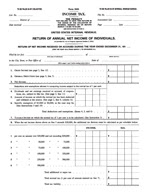 Tax day 2012 has arrived! And what better way to mark the day where your income taxes have finally come due than by providing another form for you to fill out just so you can see how much you would have been taxed when income tax forms were first issued by the IRS in 1913!
Tax day 2012 has arrived! And what better way to mark the day where your income taxes have finally come due than by providing another form for you to fill out just so you can see how much you would have been taxed when income tax forms were first issued by the IRS in 1913!
Our tool below is based upon the first page of the original Form 1040, which originally consisted of just four pages: the summary sheet modeled below (Page 1), the Gross Income calculation sheet (Page 2), the General Deductions sheet (Page 3) and finally, one page of Instructions (Page 4). Yes, you read that right. Just one page of instructions!
We'll make it just a bit easier still. All you need to do is to enter the indicated data (shown in boldface type) below with your figures from this year, and we'll take care of the math (which we show in the shaded rows of the form!):
Excerpts from the Instructions
3. The normal tax of 1 per cent shall be assessed on the total net income less the specific excemption of $3,000 or $4,000 as the case may be. (For the year 1913, the specific exemption allowable is $2,500, or $3,333.33, as the case may be.) If, however, the normal tax has been deducted and withheld on any part of the income at the source, or if any part of the income is received as dividends upon the stock or from the net earnings of any corporation, etc., which is taxable upon its net income, such income shall be deducted from the individual's total net income for the purpose of calculating the amount of income on which the individual is liable for the normal tax of 1 per cent by virtue of this return.
19. An unmarried individual or a married individual not living with wife or husband shall be allowed an exemption of $3,000. When husband and wife live together they shall be allowed jointly a total exemption of only $4,000 on their aggregate income. They may make a joint return, both subscribing thereto, or if they have separate incomes, they may make separate returns; but in no case shall they jointly claim more than $4,000 exemption on their aggregate income.
Well, wasn't that a fun exercise! Are you ready for the "improved" modern version of the same thing now?
As a final note, we first published our "Original Form 1040" tool back on 10 April 2007 - we hope you enjoyed this trip to yesteryear!